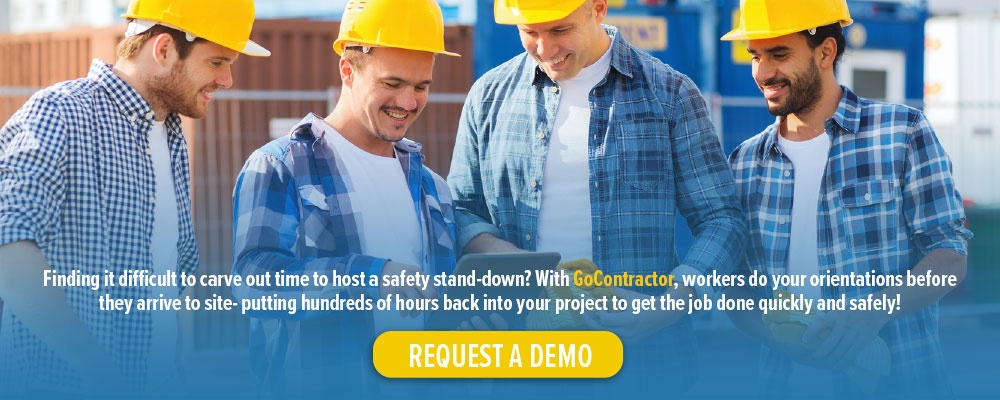 Has your company ever had a workplace fatality? If so, you know that there’s nothing worse than telling a family the tragic news. In 2014, the final count of fatal work injuries in the United States was 4,821, up from a preliminary count given in September 2015 and the highest total since 2008. Globally, more than 2.3 million workers die every year from occupational accidents and work-related illnesses, yet the sad part is that many workplace fatalities could have been easily prevented. Fortunately, businesses have a powerful new weapon in the battle against workplace fatalities—safety stand-downs. Designed to boost workplace safety, safety stand-downs offer numerous benefits for today’s organizations. Paramount among these benefits is the chance to engage work forces—including both direct employees and contractors—on critical safety issues and generate valuable feedback that can improve your organization. Safety stand-downs also highlight opportunities to prevent workplace incidents, educate workers on best practices, and review hazards at an existing job site, among other things. Encourage Workers to Discuss Common Safety Issues Safety stand-downs encourage workers to stop work for an hour or so and discuss common issues, like falls, unsecured equipment, and electrical hazards, as well as best practices for preventing accidents and injuries on-site. Companies pay workers for their time spent during these safety stand-downs, which encourages them to be engaged. Some industries where these meetings are proving beneficial include heavy industries such as construction and mining, as well as healthcare, law enforcement and agriculture. Backed by safety organizations and industry associations alike, safety stand-downs can make a difference when done right, which is why they’re growing in popularity. Here are some safety stand-downs that recently took place:
Has your company ever had a workplace fatality? If so, you know that there’s nothing worse than telling a family the tragic news. In 2014, the final count of fatal work injuries in the United States was 4,821, up from a preliminary count given in September 2015 and the highest total since 2008. Globally, more than 2.3 million workers die every year from occupational accidents and work-related illnesses, yet the sad part is that many workplace fatalities could have been easily prevented. Fortunately, businesses have a powerful new weapon in the battle against workplace fatalities—safety stand-downs. Designed to boost workplace safety, safety stand-downs offer numerous benefits for today’s organizations. Paramount among these benefits is the chance to engage work forces—including both direct employees and contractors—on critical safety issues and generate valuable feedback that can improve your organization. Safety stand-downs also highlight opportunities to prevent workplace incidents, educate workers on best practices, and review hazards at an existing job site, among other things. Encourage Workers to Discuss Common Safety Issues Safety stand-downs encourage workers to stop work for an hour or so and discuss common issues, like falls, unsecured equipment, and electrical hazards, as well as best practices for preventing accidents and injuries on-site. Companies pay workers for their time spent during these safety stand-downs, which encourages them to be engaged. Some industries where these meetings are proving beneficial include heavy industries such as construction and mining, as well as healthcare, law enforcement and agriculture. Backed by safety organizations and industry associations alike, safety stand-downs can make a difference when done right, which is why they’re growing in popularity. Here are some safety stand-downs that recently took place:- More than 2.5 million workers in the U.S. attended OSHA’s National Safety Stand-Down to Prevent Falls in Construction.
- OSHA banded together with industry associations and employers to host one-hour safety stand-downs last April to educate landscapers about hazards that can cause injury or death. Held in the southeastern part of the U.S., these safety stand-downs occurred on April 17 and April 18.
- The U.S. Federal Highway Administration, the state of Georgia, local government organizations and employers partnered with OSHA in April to host one-hour events to train road workers on the dangers of the job during National Highway Work Zone Awareness Week.
 Hosting a safety stand-down isn’t rocket science, but it does take preparation and planning. Safety management can conduct a stand-down by taking a break to host a toolbox talk or a meeting to discuss a safety topic, like conducting safety equipment inspections, developing rescue plans, or talking about job specific hazards, such as shaft collapses, cave-ins, and carbon monoxide poisoning in mining. For ideas on holding safety stand-downs, you can go to OSHA’s Suggestions to Prepare for a Successful “Stand-Down”. OSHA also has an events page with free events open to the public to help employers and employees plan safety stand-downs. To help, GoContractor has provided some proven tips on hosting a safety stand-down:
Hosting a safety stand-down isn’t rocket science, but it does take preparation and planning. Safety management can conduct a stand-down by taking a break to host a toolbox talk or a meeting to discuss a safety topic, like conducting safety equipment inspections, developing rescue plans, or talking about job specific hazards, such as shaft collapses, cave-ins, and carbon monoxide poisoning in mining. For ideas on holding safety stand-downs, you can go to OSHA’s Suggestions to Prepare for a Successful “Stand-Down”. OSHA also has an events page with free events open to the public to help employers and employees plan safety stand-downs. To help, GoContractor has provided some proven tips on hosting a safety stand-down:- Appoint a coordinator to plan, organize, and manage your safety stand-down. OSHA has plenty of information that can help make your safety stand-down a success.
- Pick a good time throughout the day to host the event. Stay away from lunchtime or break time. You want to make this special, so give the event its own time slot.
- Promote your safety stand-down. You want workers to take the safety stand-down seriously and join the conversation. Promoting your safety stand-down in a unique way is the best chance to do that.
- Hold the meeting in an inviting place so you can talk freely with workers; provide refreshments and snacks.
- Cover the basics. It’s the best and most logical place to start. Go over key procedures, rules, and guidelines. It doesn’t hurt to go over the basics no matter how many times you’ve done so before.
- Review existing safety procedures. Do the ones you have in place work? If not, which can you change or eliminate? What new procedures can you add?
- Choose interesting and engaging topics to hold the workers’ interest. Take suggestions from your workforce on topics and encourage feedback. Include open discussions as part of the safety stand-down if possible.
- Implement as many of the workers’ suggestions as you can. They’re in the trenches when it comes to job site safety, so they’ll have practical insights to share.
- Continue to emphasize safety once the stand-down is over. In fact, you should be encouraging safety throughout the year.
